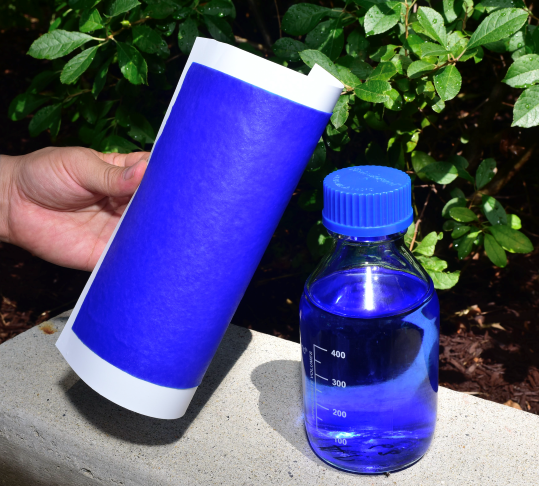 |

|
 |
Hu's team soaked CNFs in a copper-alkaline solution to enable Cu-CNF coordination, then inserted L-ions into the material by soaking it in an electrolyte, which produced a Li-Cu-CNF ion conductor. Photo credit: Al Santos for UMD. |
|
Reported in Nature on October 20, a team has put a new spin on ion conductors, which are critical for solid-state batteries. The team arranged copper (Cu) ions with cellulose nano-fibrils (CNFs) – tiny, thread-like tubes, mechanically derived from trees – to open the molecular channels for smoother, more efficient ion conduction.
The team, led by Liangbing Hu - a Herbert Rabin Distinguished Professor in the University of Maryland (UMD) Department of Materials Science and Engineering (MSE) and the founding director of Center for Materials Innovation (CMI) – soaked CNFs in a copper-alkaline solution to enable Cu-CNF coordination. They then inserted lithium ions to the material by soaking it in an electrolyte, which produced a Li-Cu-CNF ion conductor.
"By incorporating copper with one-dimensional cellulose nanofibrils, we demonstrated that the opening of molecular channels within the normally ion-insulating cellulose offers a speedier lithium-ion transport within the polymer chains," said Hu. "In fact, we found this ion conductor achieved a record high ionic conductivity among all solid polymer electrolytes, 10-100 times higher than other polymer electrolytes."
In addition to the high conductivity, this Li-Cu-CNF electrolyte offers high transference number and a wide electrochemical stability window (up to 4.5 volts), and can be applied to lithium-metal anodes and high-voltage cathodes.
It's easy to assemble, inexpensive and scalable, depending on the size of the battery. Moreover, the material is strong, flexible and eco-friendly.
"Using materials nature provides will reduce the overall impact of battery manufacture to our environment," said Yue Qi, Joan Wernig Sorensen Professor of Engineering at Brown University. "Understanding the process-structure-property relationship is the central theme for materials science research. We used molecular dynamics to track the processing conditions, predict the atomistic structures that are hard to capture by experiments, and sort out the transport mechanisms."
Perhaps more astounding, this molecular scale engineering method provides a general strategy to design solid-state ion conductors, which are applicable in areas beyond batteries, such as electrochemical synaptic devices, solid-state sensors, and redox-controlled information processing and storage.
This study was a collaborative effort between researchers at the University of Maryland, Army Research Laboratory, University of Münster, University of Tokyo, CUNY, Florida State University, University of Delaware and the National Institute of Standards and Technology.
For additional information:
Yang, C., et al. (20October2021). “Copper-coordinated cellulose ion conductors for solid-state batteries.” Nature, DOI: 10.1038/s41586-021-03885-6
October 21, 2021
|